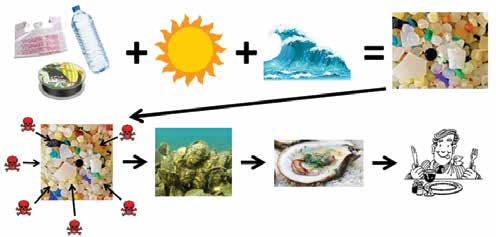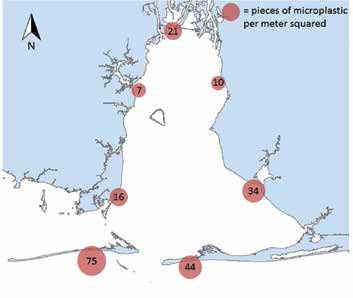Microplastics: The Tiny, Yet Massive Threat, to Our World's Oceans
By Caitlin Wessel, PhD Student, Dauphin Island Sea Lab, University of South Alabama
Every summer millions of visitors from across the USA flock to the white sand beaches of coastal Alabama, ready to enjoy a little rest and relaxation. Unfortunately, unless you are visiting a beach that gets cleaned every morning, more often than not you will also see litter. Human-made litter can be found throughout the world’s oceans and seas, even in remote areas far from human contact, and is commonly referred to as marine debris. What you may or may not notice in the sand are tiny, colorful pieces of plastic, called microplastics, which have washed ashore with the tide. In the northern Gulf of Mexico, microplastics (plastic particles smaller than 5mm) result mainly from the breakdown, by sunlight and waves, of larger plastic trash floating in the oceans but can also come from products containing microbeads, like toothpaste and face wash. Scientists from the University of Georgia estimated that 4.8 to 12.7 million metric tons of plastic trash made its way into the ocean in just one year (2010), and current estimates indicate that 92% of the plastic floating in the world’s oceans are microplastics.

Microplastics have become a prominent pollution issue, not only in Alabama, but also throughout the world. They are small enough to be easily ingested by aquatic animals, particularly in marine and coastal environments where they float on the ocean surface. Microplastics floating in the water column can be accidentally ingested by filter-feeders and then work their way up the food chain. Our plastic can affect everything from filter-feeding oysters and mussels to shorebirds, crabs, fish, sea turtles and even dolphins and whales!
Plastics also contain concentrated toxins from their manufacturing and also from absorbing toxins found in the water column. These toxins can then be released from the plastics as they work their way through the digestive tract and end up in organ and muscle tissue. So do you need to worry about microplastics in your food? Maybe, but so far research has shown ingested microplastics accumulate mainly in the guts of organisms, although some pieces are small enough to enter the blood stream. Unfortunately, little research has been conducted about how much plastic we may be ingesting from our food and there is no information on how microplastics could be affecting humans.
Researchers at the Dauphin Island Sea Lab and the University of South Alabama are currently working on several projects with the Center for Environmental Resiliency and NOAA to determine how marine debris, big and small, is affecting Alabama and the northern Gulf of Mexico. Our data show that the amount of marine debris accumulating on beaches DOUBLES between April and May. We aren’t sure yet what is responsible, but it is likely related to the increase in tourism and fishing during that time of year. Daily monitoring of shoreline trash on Dauphin Island suggests that beach supplies (chairs, tents, sand toys, etc.) left out overnight by beachgoers frequently end up washed out to sea by storms and high tide. Once exposed to constant sunlight and wave action these large plastic items quickly begin to break down into smaller pieces and eventually become microplastics. So far everywhere we have looked for microplastics in Alabama, Florida, and Mississippi we have found them. All of us are responsible for the problem of marine debris, and it will take all of us to be the solution.

So what can you do?
- For starters recycle, but that in itself is not a solution to the problem since only about 5% of plastic is recoverable to make new products.
- We need to decrease the usage of single-use plastic items like grocery or sandwich bags and start using reusable bags and containers.
- Stop buying products that contain plastic microbeads. Read the label and look for words like microbeads, polyethylene, or polypropylene.
- Say NO to printed receipts. Over 250 million gallons of oil, 10 million trees and 1 billion gallons of water are consumed each year just for receipts printed in the USA, generating 1.5 billion pounds of waste.
- Use outdoor trash bins with lids- 19 percent of litter results from trash blowing out of waste bins or the backs of pickup trucks.
- Buy a reusable mug or container for coffee and other drinks. Many places will even give you a discount for bringing your own cup.
- Drink filtered or tap water out of reusable containers instead of buying bottled water. Beverage bottles are the fourth most common litter item found in Alabama.
- All of us are responsible for the problem of marine debris, and it will take all of us to be the solution.




